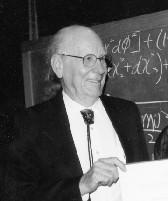Jerry E. Bishop, 76, former deputy news editor for science, technology, and medicine for the Wall Street Journal, died October 26, after a long fight against lung cancer.
He was a NASW member for 45 years, a former editor of ScienceWriters, and past president of the Council for the Advancement of Science Writing.
Bishop was born in Dalhart, Tex., on March 29, 1931, and began his newspaper career as a delivery boy for the Dalhart Texan, a small daily published by his father. He received a bachelor's degree in journalism from the University of Texas, Austin, in 1952. While still in college, he edited a suburban weekly.Bishop joined the Wall Street Journal in 1955 as a copyreader in the Dallas bureau and was soon promoted to reporter. In 1957, he was transferred to New York as a rewrite man and a year later was assigned to report on medical research. He moved to the Washington, D.C. bureau in 1959 for a year before returning to the New York office for the rest of his career. He retired in 1996 after covering science and medicine for the Wall Street Journal for 40 years.
An intrepid science reporter, his assignments included covering Antarctic exploration and the U.S. manned space program. In 1989, Bishop found himself at the forefront of a news story and controversy for his coverage of the startling announcement by two University of Utah chemists that they had created a simple apparatus that generated low-level fusion reactions yielding heat for hours at a time.
The claim of so-called "cold fusion" seemed so implausible that many media outlets at first refused to print the story. But Bishop was less inhibited. Not only did he break the story one day before the University of Utah now-famous press conference, but in the weeks immediately following that announcement he reported frequently on the claims emanating from Utah and from other laboratories. His reports came more often and were generally longer than those of most major newspapers, and he did not always write as a skeptic as did other science reporters covering the story.
Bishop was accused by skeptics in the physics community of compounding the cold fusion hype. "But the job of reporters is to report news," he would later say in an interview. "If some authority, like a scientist in the case of cold fusion, says it's not true, you don't kill the story you report the controversy."
Bishop was selected by the American Institute of Physics (AIP) as the winner of its annual science writing award for the year 1989. The announcement by the AIP, a professional umbrella group that includes the American Physical Society, that its annual award for excellence in science writing would be given to Bishop raised more hackles. "Whatever one thinks of this particular series, one must recognize Jerry Bishop as one of the finest science writers in America," said Kenneth W. Ford, AIP executive director, in defending the AIP's decision to present Bishop with the award.
Throughout his career Bishop's tireless efforts have notably advanced the profession of science journalism. He was a member of the CASW board for more than two decades and served as CASW president from 1997 to 2006. During this time he worked closely with CASW Executive Director Ben Patrusky on the council's annual New Horizons in Science Briefing. Bishop's memory for detail and penetrating questions at the briefings were inspiring. He was a role model to generations of reporters.
Although he called New York City home for nearly four decades, Bishop remained a Texan through and through who displayed quiet professionalism, sported a signature ponytail, and wore bolo ties and cowboy boots with his suits. A fan of bluegrass music, upon retirement Bishop took up playing the banjo.
Bishop is co-author with Michael Waldholz of Genome, The Story of Our Astonishing Attempt to Map All the Genes in the Human Body, published in 1990. He is the recipient the NASW Science in Society Award and other major writing awards from the American Heart Association, American Medical Association, AAAS, and American Chemical Society. In 1995, he was elected to lifetime honorary membership in Sigma Xi, the Scientific Research society.
More from the Wall Street Journal Online.




